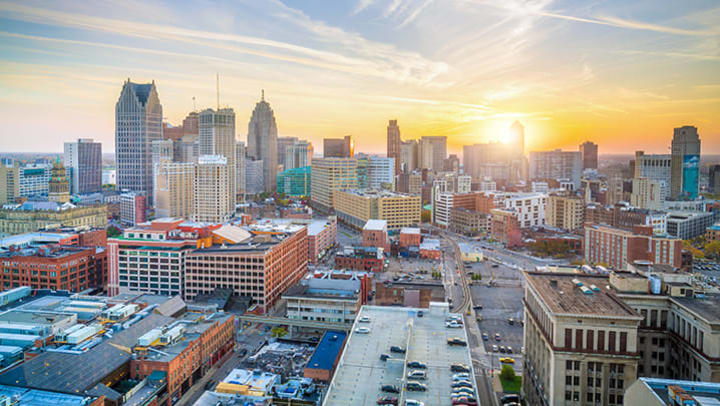SON OF “HOW THEY GOT THEIR NAMES”
by Gary Weissman (Apt. 302)
In the last thrilling episode, we discussed the origin of such place names as Michigan, Canton Township, and Wayne County. Today we take up the origin of the names of Wayne County’s neighbors – because how they got their names provides insights into Michigan’s history.
Four Michigan counties are adjacent to Wayne (Washtenaw to the west; Oakland to the north, Monroe to the south, and Macomb to the northeast), Another four counties are on the tier next to adjacency (Jackson to the west, Livingston to the northwest, St. Clair to the northeast, and Lenawee to the southwest.
THE CABINET COUNTIES
Jackson and Livingston Counties are two of the ten, so-called “cabinet counties.” In the 1830s, Michigan lobbied hard to be admitted to the Union; the local politicians figured that it would help their case if they named some counties after members of Andrew Jackson’s cabinet. So, these ten counties got their names as part of the plan to garner support for Michigan statehood:
(1) Jackson County - after President Andrew Jackson;
(2) Calhoun County, after John C. Calhoun, Vice-President;
(3) Van Buren County, after Secretary of State (and later Vice-President) Martin Van Buren);
(4) Livingston County, after Edward Livingston, Jackson’s second Secretary of State;
(5) Berrien County, after John Berrien, Attorney General;
(6) Ingham County, after Sam Ingham, Secretary of the Treasury;
(7) Eaton County, after John Eaton, Secretary of War;
(8) Cass County, after Lewis Cass, Jackson’s second Secretary of War;
(9) Branch County, after John Branch, Secretary of the Navy {then a cabinet post}; and
(10) Barry County, after William Barry, Postmaster General.
NEIGHBORING COUNTIES
Our nearest western neighbor, Washtenaw County, was actually formed by taking pieces of territory out of both Wayne and Oakland Counties. Its name is the Native American term for the Grand River, whose headwaters lie in Washtenaw. Oakland County derived its name from the orchards of oak trees there.
Monroe and Macomb Counties derive their names from two early American heroes.
~ Monroe takes its name from James Monroe, Madison’s Secretary of State and War and later President. During the Revolutionary War, Lt. Col. Monroe was an aide-de-camp to George Washington and shared a tent at Valley Forge with John Marshall (later Chief Justice of the U.S.).
~ Macomb is named for General Alexander Macomb, a key officer in the War of 1812 and later (1828-1841) Commanding General of the U.S. Army. Michigan named a county after him because Macomb had established a fortification at Ft. Gratiot in what is now St. Clair County.
SECOND TIER COUNTIES
In addition to Jackson and Livingston Counties (both cabinet counties), the second tier includes St. Clair and Lenawee Counties.
~ St. Clair takes its name from Arthur St. Clair, the first Governor of the Northwest Territory, created by the Continental Congress before the Constitution was even a gleam in James Madison’s eye, and which comprised all of the territories (later states), including Michigan, where the original Big Ten universities are located.
~ Lenawee is a made-up name. Henry Schoolcraft, a 19th century geographer and ethnologist, later Superintendent of Indian Affairs in Michigan, named several Michigan counties by fabricating pseudo-Native American names. Along with Lenawee,other Tonto-ish County names survive in Alcona, Allegan, Alpena, Iosco, Kalkaska, and Leelanau Counties. Schoolcraft was rewarded for his work with a county named for him in the Upper Peninsula.
THE ALMOST COUNTIES
Three counties in northern Ohio were almost Michigan Counties. Owing to disparate land surveys, both the State of Ohio and the Territory of Michigan claimed a 468- square mile strip of land known as the Toledo Strip. The dispute prompted both Michigan and Ohio to enact laws in 1835 making it a criminal offense for citizens to submit to the authority of the other jurisdiction. They even sent militias to face each other across the Maumee River. Historians call it “The Toledo War,” but it was a bloodless battle: The soldiers all shot into the air.
Because Ohio was a state and had two senators and a bunch of Congressmen while Michigan was a territory with one non-voting delegate, there was no way that Michigan could win politically. Congress proposed a compromise: Ohio would get the Toledo Strip, and Michigan would be admitted to the Union, and, as a bonus, would be awarded the Upper Peninsula. In September, 1836, angry Michigan Statehood Conventioneers turned down the deal, saying that the UP was not worth anything. Employing his infamous arm-twisting, Andy Jackson persuaded the Michiganders to host a second convention in December, where they rescinded the action of the former convention and accepted the compromise. Congress admitted Michigan to the Union the next year (1837), including the UP as part of its turf.
Had Michigan somehow “won” the Toledo War, the three northwestern Ohio counties (Williams, Fulton, and Lucas) that embraced the Toledo Strip would be Michigan counties. Michiganders might have accepted the names Williams (named for David Williams, the guy who captured Benedict Arnold) and Fulton (named for Robert Fulton, the inventor of the steamboat). They would, however, have absolutely refused to keep the name Lucas, named for the Ohio Governor who sent the militia to the Maumee River and signed into law the statute making it a crime for Toledans to submit to Michigan authority.


